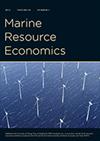A Disaggregated Analysis of Fish Demand in Myanmar
IF 1.7
3区 经济学
Q2 ECONOMICS
引用次数: 3
Abstract
We estimate demand elasticities for fish in Myanmar by fish supply sources and household groups, using a multistage budgeting approach combined with quadratic almost ideal demand system (QUAIDS). Our findings show that fish demand from all supply sources and household groups has increased with income. A substantial share of increasing demand for all fish groups is likely to come from poor and rural households because the income elasticity of demand for all fish groups is higher for poor (0.40) and rural households (0.32) than for nonpoor (0.26) and urban households (0.29). Farmed-fish consumption is the most income-responsive in all household groups. Demand for fish tends to be less price elastic for poor households because fish is their cheapest animal protein source, and substitutes are limited. Effective management policies and new technologies are essential to sustain fish supply from capture fisheries and aquaculture to meet the increasing fish demand in Myanmar.缅甸鱼类需求的分类分析
我们使用多级预算方法和二次几乎理想需求系统(QUAIDS),根据鱼类供应来源和家庭群体估计缅甸鱼类的需求弹性。我们的研究结果表明,所有供应来源和家庭群体的鱼类需求都随着收入的增加而增加。对所有鱼类群体日益增长的需求中,很大一部分可能来自贫困家庭和农村家庭,因为贫困家庭(0.40)和农村家庭(0.32)对所有鱼类种群的需求的收入弹性高于非贫困家庭(0.26)和城市家庭(0.29)。养殖鱼类消费是所有家庭群体中对收入最敏感的。对于贫困家庭来说,对鱼类的需求往往不那么具有价格弹性,因为鱼类是他们最便宜的动物蛋白来源,替代品有限。有效的管理政策和新技术对于维持捕捞渔业和水产养殖的鱼类供应至关重要,以满足缅甸日益增长的鱼类需求。
本文章由计算机程序翻译,如有差异,请以英文原文为准。
求助全文
约1分钟内获得全文
求助全文
来源期刊

Marine Resource Economics
农林科学-渔业
CiteScore
4.30
自引率
10.30%
发文量
25
审稿时长
>12 weeks
期刊介绍:
Marine Resource Economics (MRE) publishes creative and scholarly economic analyses of a range of issues related to natural resource use in the global marine environment. The scope of the journal includes conceptual and empirical investigations aimed at addressing real-world oceans and coastal policy problems. Examples include studies of fisheries, aquaculture, seafood marketing and trade, marine biodiversity, marine and coastal recreation, marine pollution, offshore oil and gas, seabed mining, renewable ocean energy sources, marine transportation, coastal land use and climate adaptation, and management of estuaries and watersheds.
 求助内容:
求助内容: 应助结果提醒方式:
应助结果提醒方式:


